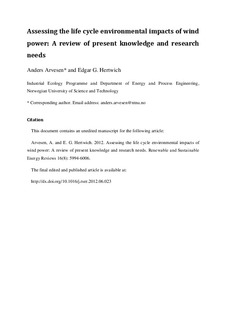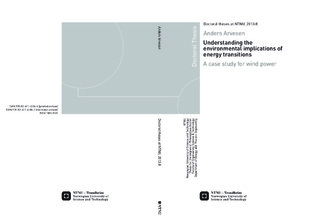| dc.contributor.author | Arvesen, Anders | nb_NO |
| dc.date.accessioned | 2014-12-19T11:50:03Z | |
| dc.date.available | 2014-12-19T11:50:03Z | |
| dc.date.created | 2013-02-20 | nb_NO |
| dc.date.issued | 2013 | nb_NO |
| dc.identifier | 606916 | nb_NO |
| dc.identifier.isbn | 978-82-471-4104-5 (printed version) | nb_NO |
| dc.identifier.isbn | 978-82-471-4105-2 (electronic version) | nb_NO |
| dc.identifier.uri | http://hdl.handle.net/11250/235015 | |
| dc.description.abstract | A fundamental change in the ways in which we provide energy to run our economies, an energy transition, is needed to mitigate climate change. Wind power is an important part of future global energy supply in most energy scenarios. This thesis aims to contribute to a better understanding of the environmental implications of energy transitions, primarily by examining the case of wind power. This involves new investigations of both potential negative impacts of wind power and the positive role of the technology in emission reduction, as well as a critical review of past research. Three papers on wind power are presented: a comprehensive literature review of life cycle assessments (LCA) of wind power, a scenario-based LCA of large-scale adoption of wind power, and an LCA of an offshore wind farm. A hybrid LCA methodology is employed in the scenario-based LCA and LCA of an offshore wind farm. Another paper is presented which is not concerned with wind power in particular, but takes the form of an evaluation of limitations of climate change mitigation literature. It helps to achieve the aim stated above by bringing together knowledge of indirect effects of mitigation measures, and by elucidating how these effects may influence the viability of proposed mitigation strategies.
The literature review aims to take stock of insights from past research, with a particular view to identifying remaining challenges. A survey of results indicates 0.063 (±0.061) and 0.055 (±0.037) kWh energy used and 20 (±14) and 16 (±10) CO2e emitted per kWh electricity for onshore and offshore cases. Evidence suggests strong positive effects of scale in the lower end of the turbine size spectrum, but is inconclusive for the megawatt range. LCAs tend to assume higher capacity factors than current real-world averages. Limitations of existing research are discussed; this includes poorly understood toxicity and resource depletion impacts, cut-off errors and seemingly inconsistent modelling of recycling benefits in analyses, lack of detailed considerations of installation and use phases, and lack of future-oriented assessments.
The scenario-based LCA is an initial attempt to integrate global energy scenario analysis and LCA in order to assess the economy-wide environmental costs and benefits of wind power. The study estimates aggregated global emissions caused by wind power toward 2050, following the International Energy Agency’s BLUE scenarios. It takes into account replacement at end-of-life and changing electricity mix in manufacturing, and distinguishes emissions occurring prior to, during and after the useful life of wind turbines. Results indicate emissions of 2.3 (3.5) gigatonnes CO2e from wind power in 2007-50 in a scenario with 12% (22%) share of wind in electricity supply in 2050. A second key element of the analysis is that life cycle inventories for fossil fuel-based electricity are used to evaluate emissions savings from wind power; the evaluation is performed on the assumption that additional wind electricity, compared with a baseline, displaces fossil fuel electricity. Results suggest that emissions savings grossly exceed emissions caused by wind power, and thus confirm emission benefits of wind power. Uncertainty and limitations in scope of analysis need to be borne in mind when interpreting results.
The LCA of an offshore wind farm places special emphasis on marine vessel activities and supply of spare parts. The proposed Havsul I wind farm, Norway is used as a model. Total carbon footprint is estimated to 34 grams CO2e per kWh. Results indicate greater contributions from vessels and spare parts than has previously been thought: Offshore activities during installation and use phases contribute 25-35% to totals for several impact categories (e.g., climate change, acidification) and 43% for photochemical oxidant formation. Supply of spare parts causes 7% of climate impacts and 13% of freshwater ecotoxicity.
Assembling evidence from different research fields, the discussion paper identifies important simplifying assumptions in current climate change mitigation assessments. An argument is presented that because simplifying assumptions represent a systematic neglect of indirect, countervailing effects of greenhouse gas-mitigating measures, they lead to overly optimistic assessments, which then become a basis for unrealistic technology optimism in climate policy.
For the thesis as a whole, the most significant contribution may be the contribution to moving beyond a single-minded concentration on static, unit-based assessments in wind power LCA research; another main contribution is the use of a hybrid LCA methodology to assess the environmental impacts of large-scale adoption of wind power and an offshore wind farm. By means of LCA studies of wind power and a wider evaluation study of indirect effects of climate change mitigation measures, the thesis illustrates the significance of taking a holistic view in evaluating the environmental implications of energy technologies and transitions. | nb_NO |
| dc.language | eng | nb_NO |
| dc.publisher | Norges teknisk-naturvitenskapelige universitet, Fakultet for ingeniørvitenskap og teknologi, Institutt for energi- og prosessteknikk | nb_NO |
| dc.relation.ispartofseries | Doktoravhandlinger ved NTNU, 1503-8181; 2013:8 | nb_NO |
| dc.relation.haspart | Arvesen, Anders; Hertwich, Edgar G.. Assessing the life cycle environmental impacts of wind power. Renewable & sustainable energy reviews. (ISSN 1364-0321). 16(8): 5994-6006, 2012. <a href='http://dx.doi.org/10.1016/j.rser.2012.06.023'>10.1016/j.rser.2012.06.023</a>. | nb_NO |
| dc.relation.haspart | Arvesen, Anders; Hertwich, Edgar G.. Environmental implications of large-scale adoption of wind power. Environmental Research Letters. (ISSN 1748-9326). 6(4): 045102, 2011. <a href='http://dx.doi.org/10.1088/1748-9326/6/4/045102'>10.1088/1748-9326/6/4/045102</a>. | nb_NO |
| dc.relation.haspart | Arvesen, Anders; Hertwich, Edgar G.. Environmental implications of large-scale adoption of wind power. Environmental Research Letters. (ISSN 1748-9326). 7(3): 039501, 2012. <a href='http://dx.doi.org/10.1088/1748-9326/7/3/039501'>10.1088/1748-9326/7/3/039501</a>. | nb_NO |
| dc.relation.haspart | Arvesen, A.; Birkeland, C.; Hertwich, E. G.. The importance of ships and spare parts in LCAs of offshore power. . | nb_NO |
| dc.title | Understanding the Environmental Implications of Energy Transitions. A Case Study for Wind Power | nb_NO |
| dc.type | Doctoral thesis | nb_NO |
| dc.contributor.department | Norges teknisk-naturvitenskapelige universitet, Fakultet for ingeniørvitenskap og teknologi, Institutt for energi- og prosessteknikk | nb_NO |
| dc.description.degree | PhD i energi- og prosessteknikk | nb_NO |
| dc.description.degree | PhD in Energy and Process Engineering | en_GB |


